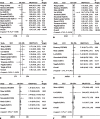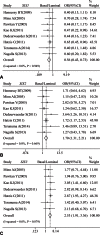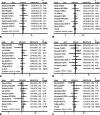Expression profile of SIX family members correlates with clinic-pathological features and prognosis of breast cancer: A systematic review and meta-analysis
- PMID: 27399099
- PMCID: PMC5058828
- DOI: 10.1097/MD.0000000000004085
Expression profile of SIX family members correlates with clinic-pathological features and prognosis of breast cancer: A systematic review and meta-analysis
Abstract
Sineoculis homeobox homolog (SIX) family proteins, including SIX1, SIX2, SIX3, SIX4, SIX5, and SIX6, have been implicated in the initiation and progression of breast cancer, but the role of each member in breast tumor is not fully understood. We conducted a systematic review and meta-analysis to evaluate the association between the mRNA levels of all 6 members and clinic-pathological characteristics and clinical outcome of breast cancer patients based on the PRISMA statement criteria.ArrayExpress and Oncomine were searched for eligible databases published up to December 10, 2015. The association between the mRNA expression of SIX family members and clinic-pathological features and prognosis was measured by the odds ratio (OR), hazard ratio (HR), and the corresponding 95% confidence interval (CI), respectively. All statistical analyses were performed using STATA software.In total, 20 published Gene Expression Omnibus (GEO) databases with 3555 patients were analyzed. Our analysis revealed that patients with SIX1 overexpression had worse overall survival (OS) (HR: 1.28, 95% CI: 1.03-1.58) and shorter relapse-free survival (RFS) (HR: 1.28, 95% CI: 1.05-1.56), and much worse prognosis for luminal breast cancer patients with SIX1 overexpression (OS: HR: 1.64, 95% CI: 1.13-2.39; RFS: HR: 1.43, 95% CI: 1.06-1.93). We found that patients with higher SIX2 level had shorter time to both relapse and metastasis. However, high SIX3 mRNA level was a protective factor for OS and RFS of basal-like breast cancer patients.Our study suggested that members of SIX family played distinct roles in breast cancer. Detailed analysis of the expression of the SIX family members might provide useful information to predict breast cancer progression and prognosis.
Conflict of interest statement
The authors have no conflicts of interest to disclose.
Figures







Similar articles
-
The expression profile and clinic significance of the SIX family in non-small cell lung cancer.J Hematol Oncol. 2016 Nov 8;9(1):119. doi: 10.1186/s13045-016-0339-1. J Hematol Oncol. 2016. PMID: 27821176 Free PMC article. Review.
-
Overexpression of MMP Family Members Functions as Prognostic Biomarker for Breast Cancer Patients: A Systematic Review and Meta-Analysis.PLoS One. 2015 Aug 13;10(8):e0135544. doi: 10.1371/journal.pone.0135544. eCollection 2015. PLoS One. 2015. PMID: 26270045 Free PMC article. Review.
-
Sineoculis homeobox homolog 1 protein is associated with breast cancer progression and survival outcome.Exp Mol Pathol. 2014 Oct;97(2):247-52. doi: 10.1016/j.yexmp.2014.07.005. Epub 2014 Jul 22. Exp Mol Pathol. 2014. PMID: 25062904
-
Molecular cloning and embryonic expression of Xenopus Six homeobox genes.Mech Dev. 2001 Mar;101(1-2):271-7. doi: 10.1016/s0925-4773(00)00572-4. Mech Dev. 2001. PMID: 11231090
-
Sineoculis homeobox homolog 1 protein as an independent biomarker for gastric adenocarcinoma.Exp Mol Pathol. 2014 Aug;97(1):74-80. doi: 10.1016/j.yexmp.2014.05.007. Epub 2014 May 24. Exp Mol Pathol. 2014. PMID: 24866365
Cited by
-
The expression profile and clinic significance of the SIX family in non-small cell lung cancer.J Hematol Oncol. 2016 Nov 8;9(1):119. doi: 10.1186/s13045-016-0339-1. J Hematol Oncol. 2016. PMID: 27821176 Free PMC article. Review.
-
Transcriptional factor six2 promotes the competitive endogenous RNA network between CYP4Z1 and pseudogene CYP4Z2P responsible for maintaining the stemness of breast cancer cells.J Hematol Oncol. 2019 Mar 4;12(1):23. doi: 10.1186/s13045-019-0697-6. J Hematol Oncol. 2019. PMID: 30832689 Free PMC article.
-
The Significance of SIX1 as a Prognostic Biomarker for Survival Outcome in Various Cancer Patients: A Systematic Review and Meta-Analysis.Front Oncol. 2021 Oct 21;11:622331. doi: 10.3389/fonc.2021.622331. eCollection 2021. Front Oncol. 2021. PMID: 34745930 Free PMC article.
-
The clinical significance of CXCL5 in non-small cell lung cancer.Onco Targets Ther. 2017 Nov 21;10:5561-5573. doi: 10.2147/OTT.S148772. eCollection 2017. Onco Targets Ther. 2017. PMID: 29200871 Free PMC article.
-
Transcriptome profiling of caspase-2 deficient EμMyc and Th-MYCN mouse tumors identifies distinct putative roles for caspase-2 in neuronal differentiation and immune signaling.Cell Death Dis. 2019 Jan 22;10(2):56. doi: 10.1038/s41419-018-1296-0. Cell Death Dis. 2019. PMID: 30670683 Free PMC article.
References
-
- Siegel RL, Miller KD, Jemal A. Cancer statistics, 2016. CA Cancer J Clin 2016; 66:7–30. - PubMed
-
- Radenkovic S, Milosevic Z, Konjevic G, et al. Lactate dehydrogenase, catalase, and superoxide dismutase in tumor tissue of breast cancer patients in respect to mammographic findings. Cell Biochem Biophys 2013; 66:287–295. - PubMed
-
- Pearson JC, Lemons D, McGinnis W. Modulating Hox gene functions during animal body patterning. Nat Rev Genet 2005; 6:893–904. - PubMed
-
- Li X, Oghi KA, Zhang J, et al. Eya protein phosphatase activity regulates Six1-Dach-Eya transcriptional effects in mammalian organogenesis. Nature 2003; 426:247–254. - PubMed
Publication types
MeSH terms
Substances
LinkOut - more resources
Full Text Sources
Other Literature Sources
Medical
Research Materials
Miscellaneous

